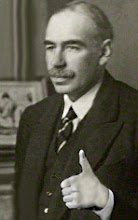Keynes discusses the business cycle in Chapter 22 of The General Theory of Employment, Interest, and Money (1936).
At the end of the chapter, Keynes has an important discussion of the role of inventories and cycles:
“Even to-day it is important to pay close attention to the part played by changes in the stocks of raw materials, both agricultural and mineral, in the determination of the rate of current investment. I should attribute the slow rate of recovery from a slump, after the turning-point has been reached, mainly to the deflationary effect of the reduction of redundant stocks to a normal level. At first the accumulation of stocks, which occurs after the boom has broken, moderates the rate of the collapse; but we have to pay for this relief later on in the damping-down of the subsequent rate of recovery. Sometimes, indeed, the reduction of stocks may have to be virtually completed before any measurable degree of recovery can be detected. For a rate of investment in other directions, which is sufficient to produce an upward movement when there is no current disinvestment in stocks to set off against it, may be quite inadequate so long as such disinvestment is still proceeding.This seems to be confirmed by modern studies of the business cycle (Knoop 2010: 18; Sorkin 1997: 569).
We have seen, I think, a signal example of this in the earlier phases of America's ‘New Deal.’ When President Roosevelt’s substantial loan expenditure began, stocks of all kinds—and particularly of agricultural products—still stood at a very high level. The ‘New Deal’ partly consisted in a strenuous attempt to reduce these stocks—by curtailment of current output and in all sorts of ways. The reduction of stocks to a normal level was a necessary process—a phase which had to be endured. But so long as it lasted, namely, about two years, it constituted a substantial offset to the loan expenditure which was being incurred in other directions. Only when it had been completed was the way prepared for substantial recovery.
Recent American experience has also afforded good examples of the part played by fluctuations in the stocks of finished and unfinished goods—‘inventories’ as it is becoming usual to call them—in causing the minor oscillations within the main movement of the trade cycle. Manufacturers, setting industry in motion to provide for a scale of consumption which is expected to prevail some months later, are apt to make minor miscalculations, generally in the direction of running a little ahead of the facts. When they discover their mistake they have to contract for a short time to a level below that of current consumption so as to allow for the absorption of the excess inventories; and the difference of pace between running a little ahead and dropping back again has proved sufficient in its effect on the current rate of investment to display itself quite clearly against the background of the excellently complete statistics now available in the United States.” (Keynes 1964 [1936]: 331–332).
https://www.marxists.org/reference/subject/economics/keynes/general-theory/ch22.htm
Certainly in the golden age of capitalism (1946-early 1970s), a number of US recessions, for example, were essentially what can be called “inventory recessions”: recessions caused by businesses’ accumulating excessive inventories which they were unable to sell when the expected demand failed to materialise or demand did not grow at a sufficiently high rate. This excessive accumulation of stock led to cuts in production and investment (basically, for many companies, changes in capacity utilisation) to liquidate inventories, and that in turn induced recessions (Sorkin 1997: 569).
Of course, since the 1980s the business cycle has been driven by other, perhaps more important, factors too: we have seen a return to the familiar 19th-century and pre-1933 pattern of asset bubbles financed by excessive debt, the bursting of these asset bubbles, financial crises, the collapse of business confidence, debt deflation, and so on.
BIBLIOGRAPHY
Keynes, J. M. 1964 [1936]. The General Theory of Employment, Interest, and Money. Harvest/HBJ Book, New York and London.
Knoop, Todd A. 2010. Recessions and Depressions: Understanding Business Cycles (2nd edn.). Praeger, Santa Barbara, Calif.
Sorkin, A. L. 1997. “Recessions after World War II,” in D. Glasner and T. F. Cooley (eds.), Business Cycles and Depressions: An Encyclopedia. Garland Pub., New York. 566–569.
